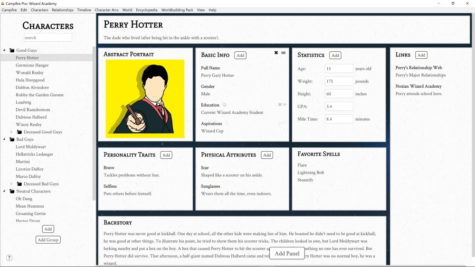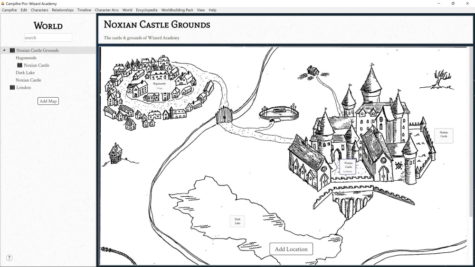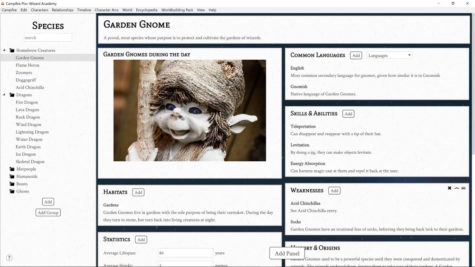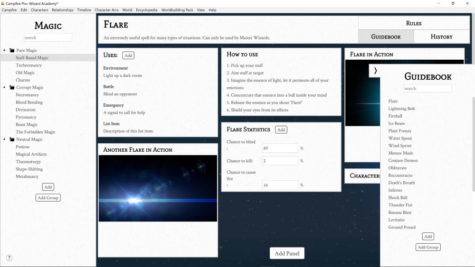This article is by L. James Rice.

Campfire Pro is a program that aims to be a comprehensive tool for worldbuilders, ranging from authors to game designers to TTRPG Gamemasters, which means it’s got many features to explore. With that in mind, it’s probably best to give a little overview of the product before delving into its details.
First off, between gaming, screenwriting, and writing in general, I’ve seen a lot of these sorts of programs over the years and been disappointed by them more often than not. Campfire’s user interface harkens back to many older programs, keeping things relatively simple, and if you’re looking flashy bells and whistles, they aren’t here. You can, however, beautify the background with a variety of themes as well as create your own. Where this program excels is in its most important aspect, functionality, while for me at least, the biggest downfall is a less than intuitive interface. This could just be my brain, results will vary, but don’t be surprised by a tiny learning curve and the occasional “good grief, did I really just do that?” This is more about little irritants than deal breakers, however, and a little tinkering tends to find answers.
The core menu has six items: Characters, Relationships, Timeline, Character Arcs, World, and Encyclopedia, and then there is the magic number seven, World Builder’s Pack, with Species, Cultures, Languages, Religions, Philosophies, Systems, Magic, and Items. For me, it’s the World Builder’s Pack that makes Campfire useful, but first, let’s take a look at the core items.
Characters
For writers who are into character sheets, this is a fine organizational tool. The character sheet template is pretty basic, but that’s just fine because of one of Campfire’s other strengths: Customization. As a writer, I’m not big on detailed character sheets, but inputting Characters ties into other aspects such as Relationships and (duh!) Character Arcs. With this in mind, I went through and input the POV characters from Eve of Snows and then added some minimal information that I find useful, namely what chapters the characters appear in.

So, I went into the “New Character” template, deleted stuff I’ll never use, and then added a “List” panel named “Chapters/Pages”. This is a lickety-split process. The List panel is just as it sounds, a panel to make lists, and there are six types of panels: Text, Image, Statistics, Lists, References, and Links. From what I can tell, the Characters Menu has the character sheet crowd covered.
Relationships
This is a fun little toy that allows the writer to plop down Characters and create Friendship Webs or Family Trees (and a generic Relationships Web). I suspect that the mileage different writers will get from this feature will vary widely. For my testing, I input a simple family tree just to play around with the feature, and first off, it doesn’t create a classic family tree as I imagined when opening the menu. The feature essentially creates flow charts, and you can color code the lines between characters to show their relationship. If you want to note a lover, bastard children, or whatever, you can do so with ease.
The default Friendship Web includes color-coding for things like friends, enemies, and various attitudes toward whatever you want. So, again, here is a handy little tool for your belt.
Timeline
This feature can be used as a traditional timeline, but each event on the timeline has plenty of customization that can be worked into it via panels. It almost gives you the feel of moving around index cards, and you can draw lines between events, list what characters are present… really, whatever you want to do. If you don’t want or need the heavy-duty capabilities of a program like Aeon Timeline, this is a great and simple feature, once you figure out the Divider Bar and slap yourself in the forehead… or well, at least that’s what I did.
Character Arcs
This is an interesting feature and not what I expected going in. What this allows you to do is to select a Character (who needs to be connected to an Event on your Timeline) and for that event note any changes to the character’s Emotional and Physical story arc. For me, I could see using this as an analytical tool when going back to examine the scene, maybe even customizing it to match up with Shawn Coyne’s The Story Grid. The writer can customize this feature at will to account for the many ways a given scene can change a Character.
World
This menu is where the world builder can begin to go nuts with one of my favorite things, maps. The interface here is adequate, but not quite ideal for my purposes, but it still does its job admirably. Maps are easy to import, and then they can be labeled and linked to other information. For instance, you can load the world map, mark an island, note its natural resources and cultures, whatever else you want, and by linking the culture, you can jump from the map to the culture to see those details. I’ve little doubt that most map fiends will find this feature useful if not downright entertaining.

Big Issue I didn’t resolve: Transparent backgrounds on labels, I need them to make maps functional for what I want, or they become clunky. I have a better system for maps, so this feature will be of little to me, but others will find it effective.
Encyclopedia
The strength of this section may or may not be using it to create a wiki… I don’t have a wiki, so I don’t know. That said, the Encyclopedia is a simple and functional location to jot down people, places, and things. For my purposes, I found this the least useful menu item. If I were filling things out here, it would pretty much be a listing of locales, as when you add the World Building Pack, most everything I’d consider doing here becomes redundant. However, I have toyed around with making templates for Cities, Fortresses, and Historical Sites. If these work out, I will consider using this feature more.
World Building Pack
Species
Have you got a rich world with a thousand species of plants and several hundred breeds of dogs, or just forty-five intelligent species? Well, here you go.

The clear intent of this menu is to cover the orcs, elves, hobbits, dragons, etc., but what I will also do is use this area to cover herbalism in the Sister Continents. You might ask, why not use the Systems category? The answer is simple: Species is better set up to handle the system. The Systems menu is more about flow charts and basic information, while the species pages are already built to hold useful data and all I need to do customize the labels.
This section is nothing flashy, but it is functional and customizable, so I love it.
Cultures
Straight forward culture creation here, where you can do as little or as much as you want. The basic layout is basic, but again, everything is customizable. To me, population is barely considered, and what I’ve done is to go through and add my own panels: Government, Military Structure, Legal Structure, etc., while deleting or altering many base panels.
Languages
This is where the insanity hits the fan. I have to avoid conlanging like the plague or I might never get books written, so this section is a horrible temptation. So far, I have not succumbed to the devil’s seductions any further than to play around and input what I already have, but there is a lot of potential here.
The system devised uses four categories: Phonetics, Dictionary, Grammar, and Pragmatics. The Dictionary alone is nice. Everything here is straightforward and customizable as far as I can tell. Having this built into your collection of other world-building tools is excellent.
Religions and Philosophies
Here again, customization is king. Religions provides you with what you might expect, a list for divine beings, links to systems and philosophies, areas for a description of the afterlife and history, typical stuff. What!? No creation myth? Easily fixed. The Sister Continents have 20+ major religions, so this menu will be getting a workout.
Philosophies is a separate section from Religions, but they are functionally very similar. It gives you some panels for jumping into a particular philosophy, and you can customize it from there.
Systems
This menu item falls into the “You Customize It” category. There are two sections to any System, a Flowchart and Information. From there, it’s all up to you to build to customize with the various panels. What did I do in my testing? I input my weights and measures systems, the basic monetary system, and started to input metallurgy. So far, I haven’t found anything to complain about here.
Magic
This menu provides the creator with some solid inspirational points and good points to get the ball rolling when thinking about a magic system, but the key is that it has three sections: Rules, Guidebook, and History. Rules is self-explanatory, but the Guidebook is a cool little feature. This pulls up a sidebar menu where you can click on entries (such as spells) from a list, and it does include a search feature if your list gets long.

Plus, since you can have multiple systems here, the possibilities for customization are endless. In fact, I could see putting a couple of the creation systems into this section because of this guidebook feature. History is like it sounds, giving you a space to discuss the origins of magic, discussions on how common magic is, and even a little Timeline feature for magic events in history.
Items
This is a straightforward menu that gives you space for different items/artifacts, providing base information such as weight, length, height, history, powers, links to characters or cultures, and any other properties you might imagine.
Conclusion
Campfire Pro didn’t wow me with any single feature, but it did get a couple of pleased nods of acknowledgment, in particular, the Guidebook under Magic. The keyword is functional, and its key feature is combining many elements into a single program. Is it the best conlang software? I doubt it. Does it have the best Timeline? I don’t think so. But by the time you put the whole thing together you have a nice program that should serve most worldbuilders well.
As always, whether the program is worth the money is a personal decision, and that is what Free Trials are all about! But time isn’t free, so the real question is whether a trial is a waste of time? And I think the answer is no, it’s not, and you might find yourself really enjoying a sit around the Campfire.
To be blunt, I went in skeptical. I’ve seen so many writing programs that I ignore most of them and build my own from whatever applications I have laying around. This one has a great deal to offer, and if you are just beginning to build out your world, then this is a great tool. For crazies like me who have entire systems already laid out in other formats, it would be a daunting process to transfer everything into this program, but there is enough convenience here that I will use several of the features in future developments.
A tip of my hat to the developers.
About the Author:
L. James RIce is an old English Lit major who later studied screenwriting at UCLA. He is the author of the international best seller and award winning Eve of Snows. You can learn more about him at his website, and you can follow him on Facebook.
About Campfire Pro:
Mythic Scribes received a free copy of Campfire Pro in exchange for an honest review of the software. You can learn more (and purchase the software) at campfiretechnology.com.

